AAA Credit Ratings Are Not Always Low Risk
Lessons from the unravelling of Tricolor
In the credit markets, a AAA rating is the gold standard. It is a promise that while nothing is risk free, this instrument is as safe as you can ever hope to get.
In September, two auto-industry players collapsed spectacularly: Tricolor, a subprime auto-lender, and First Brands, an auto-parts dealer. In the case of Tricolor, the debt was rated AAA. Clearly, there are some deep cracks in the system. There is suspicion of fraudulent practices, including pledging of same collateral for multiple loans, while being overleveraged.
Tricolor is based in Texas and serves customers who would not ordinarily get a bank loan. These are typically low income and immigrant borrowers with no credit history. Tricolor charged high interest of around 16%. The individual loans were bundled into asset-backed securities and sold to wall street. A ratings agency marked these as AAA. However, in some cases it has been found that same assets (cars in this case) became collateral for multiple loans to multiple banks. Up to 29000 overlapping loans were identified by investigators. Post bankruptcy, $1.1 billion in vehicles disappeared, and its most senior debt changed hands for 78 cents on the dollar, from AAA rating just in June.
First Brands’ bankrupcy filing followed 19 days later, collapsing under the weight of $10 billion in liabilities. In First Brands’s case, which was on an aggressive acquisition-driven growth, invoices were used as collateral for raising cash. In some cases, the same invoices were used more than once in this manner.
How can this happen ? One problematic fact is that rating agencies earn fees from the issuers of the debt itself. Given a choice of two rating agencies, most companies would choose the one who will give them a ‘good’ rating. One often sees a downgrade issued ‘after the fact’, which was the case in the First Brands case.
How could investors have forgotten about sub-prime lending crisis of 2007/2008 so quickly?
Juicy returns blind the eyes.
Some pain could have been avoided if credit investors had (i) scrutinized the underlying businesses and assets, (ii) assess historical fates of similar business models, and (iii) demanded transparency on uniqueness of collateral.
Then only after, one could look at what the ratings agencies have to say.

